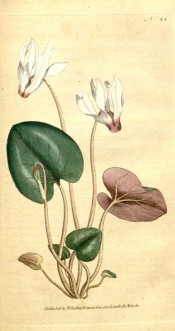Cyclamen persicum Mill.
Frost-tender tuberous perennial with heart-shaped leaves, often silver-marbled above and sweet-scented pink, red or white flowers on slender stems in winter and spring. To 20cm. The variety giganteum has larger flowers and includes the numerous varieties of florist’s cinerareas available today. [RHSE, Hortus].
Horticultural & Botanical History
‘Introduced into our gardens long since the European ones; being a native of the East-Indies, it is of course more tender than the others, and therefore requires to be treated more in the style of a greenhouse plant. It is generally cultivated in pots, in light undunged earth, or in a mixture of lome and lime rubbish, and kept in frames, or on the front shelf of a green house, where it may have plenty of air in the summer, but guarded against too much moisture in the winter.’ [BM t.44/1788]. ‘This pretty plant, as its name imparts, is a native of Persia. […] There are several varieties, differing in the greater or lesser portion of red in the flower; some of them have a slight scent.’ [LBC no.751, 1823]. There are many large flowered hybrid strains in cultivation and have been since Victorian times. Johnson’s Dictionary listed 6 varieties and Paxton’s seven. Introduced to Britain in 1731. [JD].
History at Camden Park
Listed in all published catalogues [B.102/1843].
Notes
Cyclamen persicum Sibth. & Sm. (1806) = Cyclamen graecum Link
Published Jan 18, 2009 - 04:41 PM | Last updated Jul 29, 2010 - 05:36 PM
| Family | Primulaceae |
|---|---|
| Category | |
| Region of origin | Greece to Syria |
| Synonyms |
|
| Common Name | Florist’s cyclamen |
| Name in the Camden Park Record | Cyclamen persicum |
| Confidence level | high |
